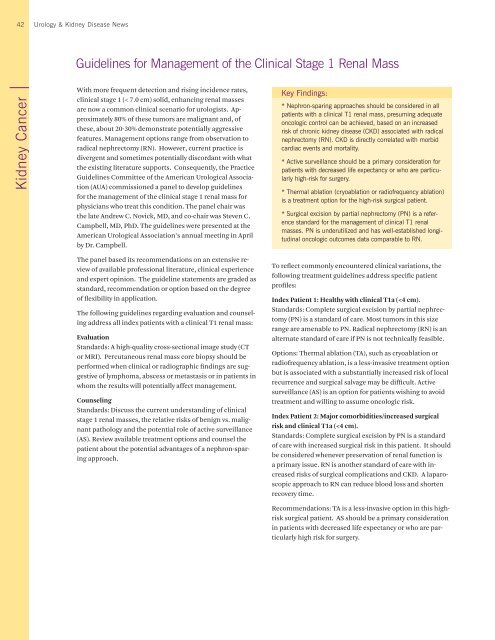Urology & Kidney Disease News Fall 2009 - Cleveland Clinic
Urology & Kidney Disease News Fall 2009 - Cleveland Clinic
Urology & Kidney Disease News Fall 2009 - Cleveland Clinic
You also want an ePaper? Increase the reach of your titles
YUMPU automatically turns print PDFs into web optimized ePapers that Google loves.
42 <strong>Urology</strong> & <strong>Kidney</strong> <strong>Disease</strong> <strong>News</strong><br />
<strong>Kidney</strong> Cancer<br />
Guidelines for Management of the <strong>Clinic</strong>al Stage 1 Renal Mass<br />
With more frequent detection and rising incidence rates,<br />
clinical stage 1 (< 7.0 cm) solid, enhancing renal masses<br />
are now a common clinical scenario for urologists. Approximately<br />
80% of these tumors are malignant and, of<br />
these, about 20-30% demonstrate potentially aggressive<br />
features. Management options range from observation to<br />
radical nephrectomy (RN). However, current practice is<br />
divergent and sometimes potentially discordant with what<br />
the existing literature supports. Consequently, the Practice<br />
Guidelines Committee of the American Urological Association<br />
(AUA) commissioned a panel to develop guidelines<br />
for the management of the clinical stage 1 renal mass for<br />
physicians who treat this condition. The panel chair was<br />
the late Andrew C. Novick, MD, and co-chair was Steven C.<br />
Campbell, MD, PhD. The guidelines were presented at the<br />
American Urological Association’s annual meeting in April<br />
by Dr. Campbell.<br />
The panel based its recommendations on an extensive review<br />
of available professional literature, clinical experience<br />
and expert opinion. The guideline statements are graded as<br />
standard, recommendation or option based on the degree<br />
of flexibility in application.<br />
The following guidelines regarding evaluation and counseling<br />
address all index patients with a clinical T1 renal mass:<br />
Evaluation<br />
Standards: A high-quality cross-sectional image study (CT<br />
or MRI). Percutaneous renal mass core biopsy should be<br />
performed when clinical or radiographic findings are suggestive<br />
of lymphoma, abscess or metastasis or in patients in<br />
whom the results will potentially affect management.<br />
Counseling<br />
Standards: Discuss the current understanding of clinical<br />
stage 1 renal masses, the relative risks of benign vs. malignant<br />
pathology and the potential role of active surveillance<br />
(AS). Review available treatment options and counsel the<br />
patient about the potential advantages of a nephron-sparing<br />
approach.<br />
Key Findings:<br />
* Nephron-sparing approaches should be considered in all<br />
patients with a clinical T1 renal mass, presuming adequate<br />
oncologic control can be achieved, based on an increased<br />
<br />
<br />
cardiac events and mortality.<br />
* Active surveillance should be a primary consideration for<br />
patients with decreased life expectancy or who are particu-<br />
<br />
<br />
<br />
ence<br />
standard for the management of clinical T1 renal<br />
masses. PN is underutilized and has well-established longitudinal<br />
oncologic outcomes data comparable to RN.<br />
To reflect commonly encountered clinical variations, the<br />
following treatment guidelines address specific patient<br />
profiles:<br />
Index Patient 1: Healthy with clinical T1a (
















